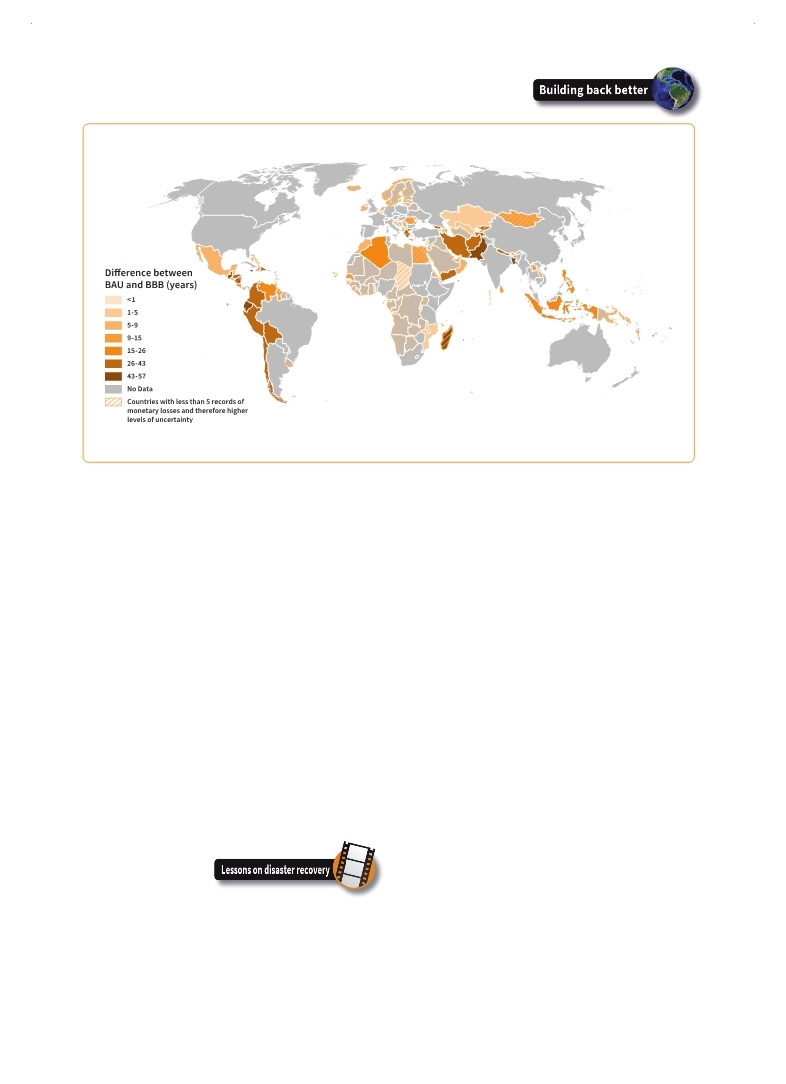 |
Global Assessment Report on Disaster Risk Reduction 2015
Making development sustainable: The future of disaster risk management |
 |
Global Assessment Report on Disaster Risk Reduction 2015
Making development sustainable: The future of disaster risk management |
|
|

170
Part II - Chapter 8
low-income households and small businesses continue to absorb the persistent losses from extensive risk. Similarly, international assistance is only forthcoming for recovery from larger disasters.
In general, countries that already have effective policy and regulatory frameworks as well as strategies and financial mechanisms in place to prevent new disaster risks can take full advantage of the gap to transform development, whereas the window of opportunity opens and closes rapidly for those which have made little progress in putting disaster risk management measures in place before disaster happens.
For example, in 2007 the principle of ensuring that risk-reducing measures are included in the recovery and reconstruction of essential public assets was introduced into Australia’s Natural Disaster
Relief and Recovery Arrangements (NDRRA) with the goal of reducing future disaster losses and reconstruction costs (Government of Australia, no date
Government of Australia. no date,Natural Disaster Relief and Recovery Arrangements, Emergency Management Australia.. . Data for assessment and recovery planning
It is clear that post-disaster needs assessments and recovery frameworks are key instruments to reach consensus on how to kick-start recovery in the shortest possible time frame as well as how to incorporate risk-reducing measures. While good assessments do not guarantee successful recovery, weak or wrong assessments will almost surely result in badly conceived response and recovery (
 GFDRR, 2014a GFDRR, 2014a GFDRR (Global Facility for Disaster Reduction and Recovery). 2014a,Understanding Risk: The Evolution of Disaster Risk Assessment since 2005, Background Paper prepared for the 2015 Global Assessment Report on Disaster Risk Reduction. Geneva, Switzerland: UNISDR.. GFDRR (Global Facility for Disaster Reduction and Recovery). 2014a,Understanding Risk: The Evolution of Disaster Risk Assessment since 2005, Background Paper prepared for the 2015 Global Assessment Report on Disaster Risk Reduction. Geneva, Switzerland: UNISDR.. Click here to view this GAR paper. Understandably, the reliability, relevance and timeliness of data is crucial, as is effective
(Source:
 Williges et al., 2014 Williges et al., 2014 Williges, Keith, Stefan Hochrainer-Stigler, Junko Mochizuki and Reinhard Mechler. 2014,Modeling the indirect and fiscal risks from natural disasters: Emphasizing resilience and “building back better”, Background Paper prepared for the 2015 Global Assessment Report on Disaster Risk Reduction. Geneva, Switzerland: UNISDR.. Williges, Keith, Stefan Hochrainer-Stigler, Junko Mochizuki and Reinhard Mechler. 2014,Modeling the indirect and fiscal risks from natural disasters: Emphasizing resilience and “building back better”, Background Paper prepared for the 2015 Global Assessment Report on Disaster Risk Reduction. Geneva, Switzerland: UNISDR.. Click here to view this GAR paper. Figure 8.5 Difference in financing gap with respect to return period from a “business as usual” (BAU) to a “building back better” (BBB) scenario
|
 
Page 1Page 10Page 20Page 30Page 40Page 50Page 60Page 70Page 80Page 90Page 100Page 110Page 120Page 130Page 140Page 150Page 160Page 161Page 162Page 163Page 164Page 165Page 166Page 167Page 168Page 169Page 170Page 171->Page 172Page 173Page 174Page 175Page 176Page 177Page 178Page 179Page 180Page 181Page 182Page 183Page 184Page 190Page 200Page 210Page 220Page 230Page 240Page 250Page 260Page 270Page 280Page 290Page 300Page 310
|
|
 
|
 
|
